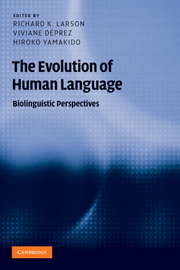Book contents
- Frontmatter
- Contents
- Figures
- Contributors
- Acknowledgments
- Introduction
- 1 The faculty of language: what is it, who has it, and how did it evolve?
- Part I Language architecture
- Part II Language and interface systems
- Part III Biological and neurological foundations
- 9 Plasticity and canalization in the evolution of linguistic communication: an evolutionary developmental approach
- 10 What is language, that it may have evolved, and what is evolution, that it may apply to language
- 11 The creative capacity of language, in what manner is it unique, and who had it?
- 12 Genetics and the evolution of language: what genetic studies reveal about the evolution of language
- Part IV Anthropological context
- Notes
- References
- Index
9 - Plasticity and canalization in the evolution of linguistic communication: an evolutionary developmental approach
Published online by Cambridge University Press: 05 June 2012
- Frontmatter
- Contents
- Figures
- Contributors
- Acknowledgments
- Introduction
- 1 The faculty of language: what is it, who has it, and how did it evolve?
- Part I Language architecture
- Part II Language and interface systems
- Part III Biological and neurological foundations
- 9 Plasticity and canalization in the evolution of linguistic communication: an evolutionary developmental approach
- 10 What is language, that it may have evolved, and what is evolution, that it may apply to language
- 11 The creative capacity of language, in what manner is it unique, and who had it?
- 12 Genetics and the evolution of language: what genetic studies reveal about the evolution of language
- Part IV Anthropological context
- Notes
- References
- Index
Summary
Introduction
In the last decade, the introduction of a developmental framework into the core of evolutionary theory has brought about a radical change in perspective. In the emerging synthesis, known as “evolutionary developmental biology” (or “evo devo”), the development of the phenotype, rather than the genetic variant, assumes a primary theoretical position, and is the point of departure for evolutionary analysis. Changes in development which lead to changed phenotypes are primary and the organism exhibiting an altered phenotype is the target of selection. Genes, as West-Eberhardt (2003) succinctly has put it, “are followers in evolution”: changes in gene frequencies follow, rather then precede, phenotypic changes that mainly arise as reactions to environmental changes. The focus of developmentally informed studies of evolution is therefore on processes of development that can generate evolutionary innovation, on the constraints and generic properties of developmental systems, on the architecture of developmental networks, and on the evolution of the ability to develop and learn (Gilbert 2003). It is clear today that in order to explain the evolution of a new trait – be it morphological, physiological, or behavioral – it is necessary to explain the evolution of the developmental processes that contribute to its construction during ontogeny. Therefore, processes leading to developmental flexibility and sensitivity to environmental variations on the one hand, and to the buffering of environmental and genetic “noise” on the other hand, are important subjects of empirical and theoretical research.
- Type
- Chapter
- Information
- The Evolution of Human LanguageBiolinguistic Perspectives, pp. 135 - 147Publisher: Cambridge University PressPrint publication year: 2010
- 26
- Cited by



